

Påsksånger och ramsor. Gullefjun Det var en kyckling som hette Gullefjun hon skulle ge sig ut på promenad Och solen lyste och gräset lockade och hela världen var så hjärtans glad.

Det fanns ett hål uti hönsgår´ns nät där genom trippade med lätta fjät den lilla Gullefjun med mjuka silkesdun och alla hönsen sa ka-ka-ka ka. När Gullfjun kommit en bit på vägen då mötte hon en svart och gammal katt. Men Gullfjun trodde inte han var farlig så han blev inte rädd ett enda skvatt. Men katten slickade bums sin nos, han tänkte nog av Gullfjun göra mos. Då hörde Gullefjun att någon skällde och det kom rusande en väldig hund. Jag såg en kärring Melodi: Det var så roligt jag måste skratta Det var så roligt, för upp i luften jag såg en kärring som flög en kvast. Jag står och tittar mot blåa berget och ser allt flera som kommer dit. På långfredagen jag ser dom komma dom ska nog styra sig hem igen. Making Starting Chains Easy. As a beginner, one of the biggest stumbling blocks to getting into the swing of crochet can be the very first step, working into the starting chain.
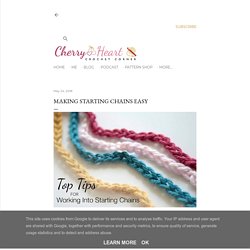
That's why people starting out begin with a classic granny or solid granny square, no trying to force your hook into those awkward chains. Even as a seasoned crocheter working that first row can be an unpleasant task, a sort of hurdle that needs to be climbed before the more agreeable business of the rest of the crochet can begin. So naturally, I'm always on the look out for ways to avoid the dreaded first chain blues and over the years I've managed to come with and stumble across some pretty useful methods.
Översättningstabeller stickor och virknålar - Creative Cia Creative Cia. Virka en magisk cirkel. Leta efter resultat för Osynlig söm. Räkna maskor - Masktäthet som inte stämmer. Sewing a Zipper into a Bag. Find yarn shops in London England. Sewing Tip: How to Measure Kids for Sewing Projects. San's Design: Bandkantning vs muddning. Ibland får jag kommentarer på mina bilder (framför allt de med bodys) som låter något i stil med: "Åh jag önskar jag hade en bandkantare så jag också kunde bandkanta sådär snyggt!

" Här kommer ett avslöjande; jag äger inte ens en bandkantare! Jag kantar alla plagg manuellt. I månadens tutorial tänkte jag visa hur jag gör när jag bandkantar. För er som är nya på det här med sömnad kommer jag också att visa skillnaden på bandkantning och muddning och jag börjar med muddning (för det är oftast lite enklare). När jag började sy, jag hade ingen aning om vad jag pysslade med! Men man lär sig! Muddar gör man ju en del när man syr allt möjligt.
Jag börjar med att sy ihop alla axelsömmar på tröjan så jag får ett hål för huvudet. Sedan mäter jag omkretsen på ett ungefär. Så jag sträcker ut min muddremsa (jag skär min mudd i ca 4,5cm breda remsor för muddar och kantband) ordentligt och mäter ut ca 26,5cm, släpper den så den drar ihop sig, viker den dubbel och klipper.
I innerkurvor: dra! 2K+Save. Engelska virktermer på Svenska. 11 Drool-Worthy Craft Room Organization Ideas. Whether your craft space is a dedicated room or a small corner, check out these drool-worthy organization ideas and your projects won’t get lost in clutter!
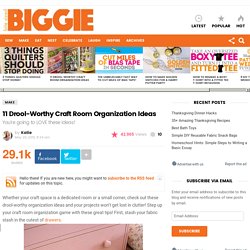
Step up your craft room organization game with these great tips! First, stash your fabric stash in the cutest of drawers. Or file your fabric away like your other important “materials”. via. Bag Zipper Tutorial - Sister's Choice Quilts. Pat suggested that I do a tutorial on how to attach the zippers to the little bags I am making, and I thought it was a brilliant idea.

I am not going to show you the details of the whole pattern, because I want you to buy it (Zippy Strippy by Atkinson Designs). However, the zipper instructions are pretty generic, so here we go. Sewing Tips and Tricks: 120+ of our best ideas. When it comes to sewing tips and tricks…there’s no shortage of resources.
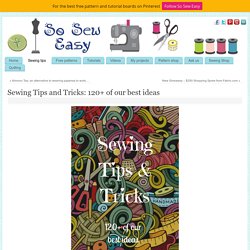
Indeed, when we Google a basic question concerning a sewing machine attachment we’ve just purchased or a new technique we need to master before we can complete our next project, sometimes we find ourselves overwhelmed by choices. However, it makes a big difference to have all those Sewing Tips provided by a source you know you can trust, collected and set out in a manner that’s logical and easy to make use of. That’s exactly the reason why we decided to put together this handy list of Sewing Tips and Tricks. I’m talking about everything you’ll need as a beginner or anything short of a seasoned expert (and even then!).
How to Sew a Zipper Into Clothing. Zippers can be one of the most intimidating techniques for someone new to sewing.

But honestly, there is nothing to fear. Putting in a zipper really isn't as hard as it looks. Once you learn the tricks, you'll be confidently sewing zippers into everything from dresses and pants to bags and pillows. Things You'll Need Zipper (2 inches longer than needed) Iron and ironing board Transparent tape Zipper foot Seam ripper Sharp scissors. Metric Conversions Quilt Sew. Samlade pysseltips / All my DIY’s. A sunny sewing room and folding fabrics to size.
It’s a new year, a new start and a new sewing room!
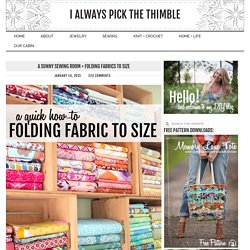
Here’s a little peek around at what I’ve been doing during my 2 month blogging hiatus. Folding fabrics and getting organized! I’ll show you how I spent a couple afternoons folding fabrics to fit inside 4 different sized cubbies and crates while watching documentaries on Hulu. In my pajamas. (Sigh.) But first, have a peek around my new sewing room. Make: DIY Projects and Ideas for Makers. Tryckknappar. Discount system: 25pcs - 20% discount 50pcs or more - 34% discount Nickle-free snap-on buttons.
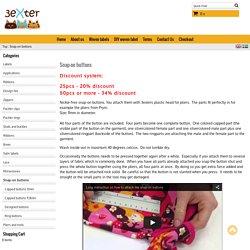
You attach them with 3exters plastic head for pliers. The parts fit perfectly in for example the pliers from Prym.Size: 11mm in diameter. All four parts of the button are included. Wash inside-out in maximum 40 degrees celcius. Mad mim Finishing Techniques for Knit Fabric // Stretch Yourself. This series is sponsored by Baby Lock.
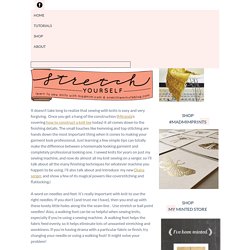
For over 40 years, Baby Lock has been dedicated to the love of sewing by creating machines for sewing, embroidery, quilting and serging – all with ease-of-use, high quality and a touch of elegance. It doesn’t take long to realize that sewing with knits is easy and very forgiving. Once you get a hang of the construction (Miranda‘s covering how to construct a knit tee today) it all comes down to the finishing details.
The small touches like hemming and top stitching are hands down the most important thing when it comes to making your garment look professional. Just learning a few simple tips can totally make the difference between a homemade looking garment and completely professional looking one. A word on needles and feet. Finishing Neck Openings: .:Mirre syr:.: Att sy i en osynlig dragkedja. Quick reference guide. How to Sew - sewing patterns and tips for beginners. How to Sew Straight. The most important tip: Keep your eye on the fabric and guide, not the needle! What's a guide? It's a device that helps regulate an operation...in this case, the operation is sewing straight.
Free patterns and tutorials to sew for your kitchen. Are you hoping to have friends over for parties, picnics and BBQs this summer? If you are you need to look through these free things to sew for your kitchen. I just love an excuse to sew something new, and there’s none better than sewing something useful. Using the Best Interfacing or Stabilizer for the Job. If you have ever gone shopping for interfacing or stabilizer, you know that there are a whirlwind of options! It can be daunting to know which one(s) you need to buy if you don't know exactly what you're looking for!
But shopping for these products is not quite as complex as it seems and with a little info today I'm sure we can make your experience a lot better! I actually enjoy shopping for it now that I know what I'm looking for. First let's talk about the difference between interfacing and stabilizer. For the most part, interfacing is ironed and/or sewn into the garment permanently to give it stability and structure (such as around buttonholes and collars). Many of our CKC patterns call for "interfacing" without specifying which type.
How to Sew with Oilcloth + mini project. It’s the first day of our Don’t Fear the Fabric series! I’m tackling Oilcloth and Kate’s talking about Leather. So make sure you hop over to her blog when you’re done drooling over these happy fabrics. (don’t worry, it’s all water-proof. We can wipe up any messes)